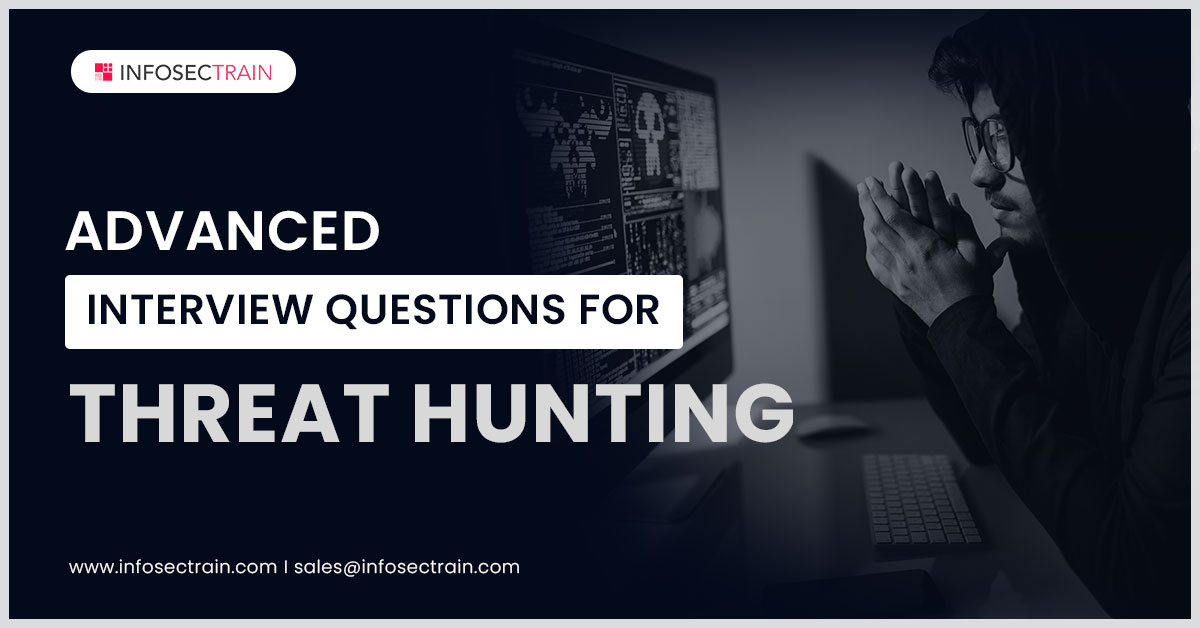Advanced Interview Questions for Threat Hunting
Threat Hunting is a process of digging deep into the networks, servers, and systems to find out malicious activities. If the threat hunting process is weak, then the attacker can remain unidentified in the network for a long time, processing malicious activities like collecting confidential data and accessing the credentials of the organization. Organizations have evolved and improved the Threat Hunting process to avoid threats.

This blog focuses on the advanced Threat Hunting questions that would help in an interview.
1. What is Threat Hunting?
Security Analysts utilize a proactive technique called “threat hunting” to spot new or difficult-to-remediate cyberthreats in the organization’s network. It involves using iterative approaches to look for signs of a breach as well as risks like Advanced Persistent Threats (APTs) and hacker tactics, techniques, and procedures (TTPs), which harm the current system.
2. What are the various steps of the Threat Hunting process?
Threat Hunting process involves five steps:
- Step 1: Hypothesis
- Step 2: Collect and Process Data
- Step 3: Trigger
- Step 4: Investigation
- Step 5: Response/Resolution
3. What are the key metrics to find the effectiveness of Threat Hunting?
- Number of incidents by severity
- Dwell Time of any incident
- Insecure practices
- Number of detection gaps
- Login gaps
- False-positive rate
- Number of hunts
4. Explain the difference between threat hunting and threat detection.
Threat hunting and threat detection sound similar, but they are different. Threat Hunting is an early stage of threat detection that focuses on identifying threats at the beginning of an attack. In comparison, Threat detection is a set of processes that focuses on identifying threats before, during, or after the attack.
5. List out the types of Threat Hunting.
- Structured Threat Hunting
- Unstructured Threat Hunting
- Situational or Entity-driven Threat Hunting
6. What are the three essential characteristics of an effective threat-hunting tool?
The following are the three essential characteristics of effective threat hunting:
- A robust analytics engine, such as Machine learning or AI-based, is used to help the threat hunting team identify threats.
- It should include logs, such as EDR logs, antivirus logs, firewall/proxy logs, and Windows events logs.
- It should include a SIEM system that should be located in the tool for easy access and to correlate information in real time.
7. What is a Diamond Model in Threat Hunting?
The Diamond Model is an approach to performing intelligence on intrusion analysis events. It includes four core features:
- Adversary
- Victim
- Infrastructure
- Capability
These four core features are connected to delineate the relationship between each other that is used to examine to uncover the insights and collected information of malicious activities.
8. List out the five steps of the threat-hunting maturity model.
The five steps of the threat-hunting maturity model are:
- HMO- Initial
- HM1- Minimal
- HM2- Procedure
- HM3- Innovative
- HM4- Leading
9. What are the sources of Data Leakage?
The sources of Data Leakage can be categorized as follows:
- Using insecure source code for the developed web-based application.
- Employee indiscretion.
- Server, workstation, or wireless device misconfigurations.
- Any unanticipated technological problems within the IT infrastructure.
- Inadequate security procedures that have been implemented at the company.
10. What are the top tools used by Threat Hunters?
The following are the tools used by the Threat Hunters:
- DNSTWIST
- Cuckoo Sandbox
- Exabeam Threat hunter
- Gnuplot
- Phishing Catcher
- Attacker KB
- Wireshark
- YARA
11. What are the skills required to become a threat hunter?
The following are the essential skills required to become a Threat hunter:
- Good understanding of data and data analytics tools and techniques to analyze the collected data.
- Understanding of the behavioral pattern of the network.
- Ability to analyze new threats and understand the malware, its capacity, and the impact it might cause.
- Ability to understand the operational process of the company.
- Good communication to share the identified information with the team.
12. Why do Threat Hunters use the MITRE ATT&CK framework?
Threat Hunters use the MITRE ATT&CK framework to identify, prevent, and respond to threats by mapping security controls to ATT&CK. It helps to understand the adversary behavior of threat actors who target the endpoints of the network.
13. Explain the difference between threat and vulnerability.
Threat exploits the vulnerability and damages the network or system of the organization. At the same time, vulnerability is a weakness in the network, procedure, or system which is likely to be exploited.
14. Explain EDR and its uses.
Endpoint Detection and Response (EDR), which helps detect the threat and offers quick actions to hunt the threat proactively.
- Mitigate the attacks in-progress
- Provides high-speed response
- Detects the identified and unidentified threats
15. What is STRIDE in Threat Modelling?
STRIDE (Spoofing, Tampering, Repudiation, Information Disclosure, Denial of Service, and Elevation of privilege) is a model of threats used to identify digital security threats and helps reason the system. It includes processes, data flows, data stores, and trust boundaries.
Final Words
Along with these Advanced Interview Questions for Threat Hunting, we also have another Top 15 Interview Questions for Threat Hunters that would help you get through all these questions before going for an interview.
InfosecTrain is one of the leading cloud and security providers with certified and expert trainers who provide a detailed explanation of all concepts and clear all your doubts. In the Threat Hunting Training course from InfosecTrain, you will learn concepts like Threat Hunting terminologies, Web Hunting, Threat Hunting hypotheses, Endpoint Hunting, Malware Hunting, Network Traffic Hunting, Hunting with ELK, etc. So, check out and enroll now.







 1800-843-7890 (India)
1800-843-7890 (India)